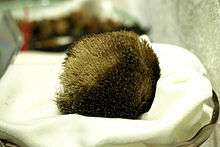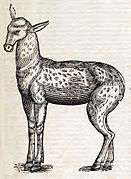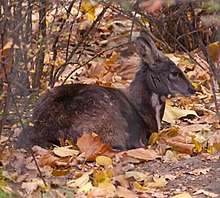Deer musk
Deer musk is a substance with a persistent odor, obtained from the caudal glands of the male musk deer.

Although more commonly referred to as "musk", the term itself is often used to describe a wide variety of "musky" substances from other animals such as the African civet ("civet musk") or various synthetic musks whose compound exhibits some character of deer musk.
The demand for deer musk has led to a severe decrease in musk deer populations. Six of the seven musk producing species are listed as Endangered.
Cultural history
The etymology of the name musk, originating from Indian Sanskrit मुस्कस् muṣká, (‘"small testicle") via Middle Persian مشک mušk, Late Greek μόσχος (moskhos), Late Latin muscus, Middle French musc and Middle English muske,[1][2] hints at its trade route.
Musk deer—more commonly known as Kasturi in India—of the Himalayas is one of the most endangered species in the region. Scent glands from these deer can fetch thousands of rupees and are used for manufacturing perfume and traditional medicine.
Deer musk was unknown in the Western world in classical antiquity and reference to it does not appear until the 5th century AD when it is mentioned in the Talmud (Brachot 43.) as an animal-based fragrance. The 6th-century Greek explorer Cosmas Indicopleustes mentioned it as a product obtained from India.[3] Soon afterwards Arab and Byzantine perfume makers began to use it, and it acquired a reputation as an aphrodisiac.[3] Under the Abbasid Caliphate it was highly regarded, and the caliphs of Baghdad used it lavishly. In the early 9th century, Al-Kindi included it in a large number of his perfume recipes and it became one of the important luxury items brought by Arabian ships from the East.[3]
Deer musk has been a key constituent in many perfumes since its discovery, being held to give a perfume long-lasting power as a fixative. Despite its high price, musk tinctures were used in perfumery until 1979, when musk deer were protected as an endangered species by the Convention on the International Trade in Endangered Species of Wild Flora and Fauna (CITES). Today the trade quantity of the natural musk is controlled by CITES but illegal poaching and trading continues.[4]
 "Musk-cat", woodcut from Hortus Sanitatis, 1490
"Musk-cat", woodcut from Hortus Sanitatis, 1490 Musk-Cat, 1658
Musk-Cat, 1658
Harvesting

Musk deer belong to the family Moschidae. White-bellied musk deer occurs in the Himalayas from Pakistan to China. To obtain deer musk, the deer is killed and its gland, also called "musk pod", is removed.[5] Harvesting of musk pods is the main threat to Moschus species.
In China, musk pods from the Dwarf musk deer, the Alpine musk deer (sifanicus), and the Siberian musk deer are currently accepted per the Pharmacopoeia of the People's Republic of China,[6] although official sources claim that more than 99% of the said use has been replaced by an artificial replacement of an undisclosed composition.[7]
Properties
Deer musk is of a dark purplish color, dry, smooth and unctuous to the touch, and bitter in taste. According to Encyclopedia Brittanica, "a grain of musk will distinctly scent millions of cubic feet of air without any appreciable loss of weight, and its scent is not only more penetrating but also more persistent than that of any other known substance".[8] In addition to its odoriferous principle, it contains ammonia, cholesterol, fatty matter, a bitter resinous substance, and other animal principles.
The Highest quality is Tonkin musk from Vietnam, followed by Assam and Nepal musk, while Carbadine musk from Russian and Chinese Himalayan regions are considered inferior.[4]
See also
References
- "Merriam-Webster's Online Dictionary: musk". Merriam-Webster. Retrieved 2007-04-07.
- Chantraine, Pierre (1990). Dictionnaire étymologique de la langue grecque. Klincksieck. p. 715. ISBN 2-252-03277-4.
- Groom, Nigel (1997). New Perfume Handbook. Springer. pp. 219–220. ISBN 0-7514-0403-9.
- Rowe, David J. (Ed.); Philip Kraft (2004). "Chapter 7. Aroma Chemicals IV: Musks". Chemistry and Technology of Flavours and Fragrances. Blackwell. ISBN 0-8493-2372-X.CS1 maint: extra text: authors list (link)
- Timmins, R. J.; Duckworth, J. W. (2015). "Moschus leucogaster". IUCN Red List of Threatened Species. 2015: e.T13901A61977764.CS1 maint: ref=harv (link) doi:10.2305/IUCN.UK.2015-2.RLTS.T13901A61977764.en
- "麝香 / MOSCHUS". Pharmacopoeia of the People's Republic of China. db.ouryao.com. 2015. Retrieved 10 December 2018.
- state key laboratory of bioactive substance and function of natural medicines. ""人工麝香研制及其产业化"荣获国家科学技术进步一等奖". Retrieved 19 December 2018.
发现了天然麝香中关键药效物质—抗炎多肽蛋白质类成分……作为国家保密品种, 自1994年推广以来,在全国31个省市760家企业应用,销售的433种中成药中,有431种完全用人工麝香替代了天然麝香,替代率达99%以上……相当于少猎杀900万头雄麝
- Dalby, Andrew (2000). Dangerous Tastes: The Story of Spices. University of California Press. ISBN 978-0-520-23674-5.